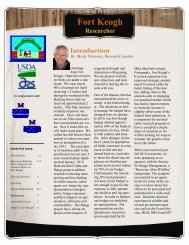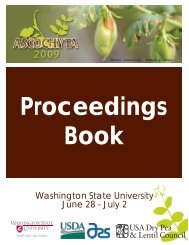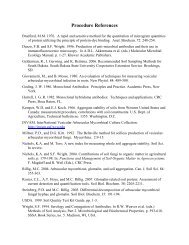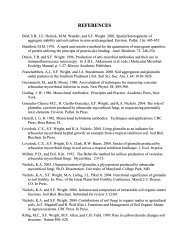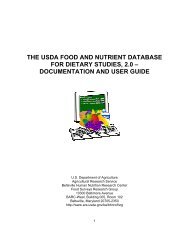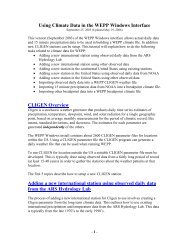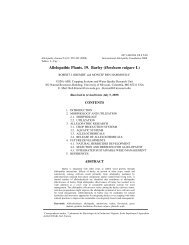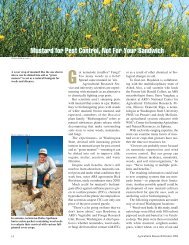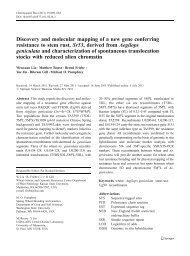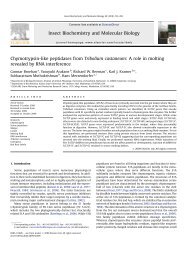a catalog of the cecidomyiidae - Agricultural Research Service - US ...
a catalog of the cecidomyiidae - Agricultural Research Service - US ...
a catalog of the cecidomyiidae - Agricultural Research Service - US ...
You also want an ePaper? Increase the reach of your titles
YUMPU automatically turns print PDFs into web optimized ePapers that Google loves.
3<br />
Cecidomyiinae, host or hosts if known. Indented below that line in chronological order is <strong>the</strong> original spelling and<br />
combination <strong>of</strong> that name, followed by any synonyms, misspellings, and emendations, with author, date, and page or<br />
plate for each name. Following each species are: <strong>the</strong> type locality or localities; kind <strong>of</strong> type; stage <strong>of</strong> type; and<br />
depository. Any new taxonomic decisions are signalled in boldface following <strong>the</strong> pertinent entries. Explanatory notes<br />
and fur<strong>the</strong>r references are occasionally provided.<br />
Misspellings.--Alternative spellings accompanying <strong>the</strong> original description are cited, as well as those in<br />
subsequent papers that might tend to mislead because <strong>the</strong>y are in headings, lists, or keys. Textual typographical errors<br />
in papers subsequent to <strong>the</strong> original that can be understood as such in context were not cited. Only <strong>the</strong> first example<br />
known to me <strong>of</strong> a misspelled name is indicated, so <strong>the</strong> term "<strong>of</strong> authors" is not used.<br />
Misidentifications.--These are only rarely noted, as in <strong>the</strong> case <strong>of</strong> economically important species, e.g. <strong>the</strong><br />
North American Asphondylia websteri that was at one time cited as A. miki, a European species.<br />
Distribution.--Ranges given are from various sources, including revisions, previous <strong>catalog</strong>s, and faunal lists. I<br />
cannot vouch for all localities cited in <strong>the</strong> literature. Most historical locality records based on galls alone, if <strong>the</strong>y do not<br />
stretch a range unduly, have been presumed correctly identified, although ultimate certainty depends on identification<br />
<strong>of</strong> <strong>the</strong> cecidomyiid inside <strong>the</strong> gall.<br />
The distribution <strong>of</strong> a species is outlined by country, generally from west to east and north to south. State,<br />
province or territory is specified for some <strong>of</strong> <strong>the</strong> larger countries, viz., Argentina, Brazil, Canada, China, India, Mexico,<br />
and <strong>US</strong>A. Russia is divided into four parts: Europe, west <strong>of</strong> <strong>the</strong> Urals; Western Siberia, <strong>the</strong> Urals east to <strong>the</strong> Yenisey<br />
River; Eastern Siberia, <strong>the</strong> Yenisey River east to Magadan Province; and <strong>the</strong> Far East, Magadan Province eastward.<br />
This generally follows <strong>the</strong> scheme used earlier in <strong>the</strong> Catalogue <strong>of</strong> Palaearctic Diptera (cf. Soós & Papp 1986) for <strong>the</strong><br />
division <strong>of</strong> <strong>the</strong> <strong>US</strong>SR. Larger island distribution is given for Indonesia and Japan. Abbreviations are used for <strong>the</strong> names<br />
<strong>of</strong> only two countries, UK for United Kingdom and <strong>US</strong>A for United States <strong>of</strong> America. Fossil distribution is given as<br />
epoch first, followed by geographic locality.<br />
Far-flung states or parts <strong>of</strong> certain countries, e.g., Hawaii (as Hawaiian Islands here), Trinidad, and Tobago,<br />
are treated for convenience as if <strong>the</strong>y were separate countries. Washington, DC, is given as "District <strong>of</strong> Columbia" so<br />
that it will not be confused with <strong>the</strong> State <strong>of</strong> Washington. No differentiation was made between Czech Republic and<br />
Slovakia for older Czechoslovakian records or among <strong>the</strong> present states formerly part <strong>of</strong> Yugoslavia, except for typelocalities<br />
and more recent records.<br />
Distribution is drawn here with a broad brush. A listing <strong>of</strong> "France, Germany" could mean that <strong>the</strong> species<br />
extends from <strong>the</strong> Baltic to <strong>the</strong> Mediterranean or only that it has been found on opposite banks <strong>of</strong> <strong>the</strong> Rhine. Most gall<br />
midges are probably not very restricted within a biome and most are probably more widely distributed than presently<br />
known. When a species has a broad range, e.g., one that has been recorded from <strong>the</strong> United Kingdom, Sweden,<br />
Germany, Latvia, European Russia, Hungary, Spain, Italy, and Greece, its distribution is summarized here as<br />
"widespread Europe." This avoids taking space for long lists <strong>of</strong> countries for common species. In <strong>the</strong> same way, I felt<br />
confident in giving a designation <strong>of</strong> "widespread eastern Nearctic" for species known from, e.g., Ontario, Canada and<br />
Florida, <strong>US</strong>A and many states between when <strong>the</strong> host occurs throughout <strong>the</strong> entire region.<br />
Hosts.--The type host or hosts for <strong>the</strong> senior name is given first, separated by a semicolon from any additional<br />
original or subsequent hosts. If <strong>the</strong> host became known only after <strong>the</strong> original description, <strong>the</strong> entry reads "Orig. unk.;"<br />
followed by <strong>the</strong> host. Three or more additional original or subsequent hosts <strong>of</strong> <strong>the</strong> same genus as <strong>the</strong> type host are not<br />
tabulated but summarized by "spp." to obviate long lists for oligophagous species. Older names for hosts are corrected<br />
to current names, but some recent name changes are not reflected here. Authors <strong>of</strong> host names are unnecessary in <strong>the</strong><br />
context <strong>of</strong> this <strong>catalog</strong> and are not supplied, but <strong>the</strong> family for plant hosts, order for fungal hosts, and family and order<br />
for animal hosts are provided because <strong>the</strong>y are valuable to anyone looking for cecidomyiids that occur on certain hosts<br />
or host groups. Many European gall makers have, subsequent to <strong>the</strong>ir original descriptions, been identified and<br />
recorded based on galls. These records are included uncritically here, but some records <strong>of</strong> gall associates, including<br />
predators and inquilines, that I suspect were not based on reared adults to critically determine <strong>the</strong>m, are left out.<br />
Type localities.--Place names are as much as possible corrected to current and consistent use. For instance,<br />
where J.-J. Kieffer used or implied only Lorraine, I have used Moselle, <strong>the</strong> current department name for that part <strong>of</strong><br />
Lorraine where he lived all <strong>of</strong> his life. For ano<strong>the</strong>r example, Kieffer variously used "La Grange," "Lagrange," "Château<br />
de La Grange," "château de la Grange," and "forêt de La Grange" for a domicile and its surrounds near Thionville in<br />
Moselle where he spent two months one summer tutoring a student (Fleur 1929) and collected a large number <strong>of</strong><br />
species that he subsequently described. All mentions <strong>of</strong> this type locality are given in this <strong>catalog</strong> as "château de La<br />
Grange, nr Thionville." I have not added <strong>the</strong> department name for uniquely named towns in France as <strong>the</strong> French Code



